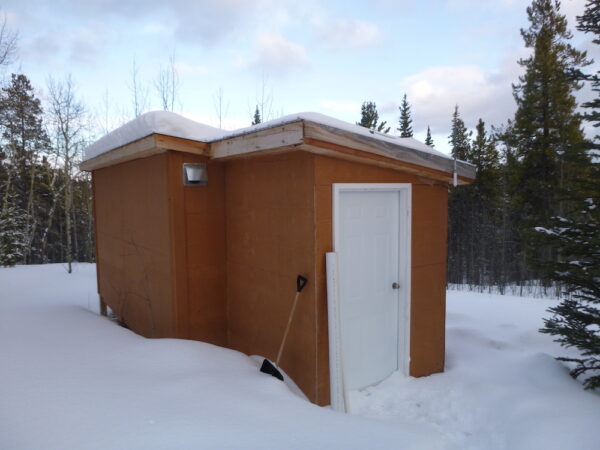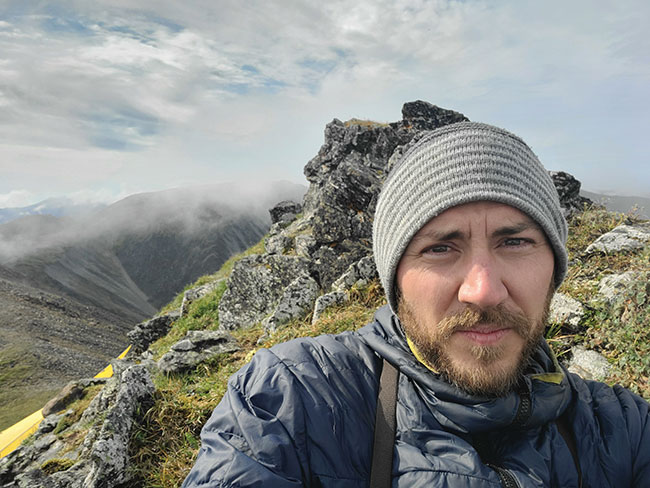
In-Depth
Digesting the North: Balance BioGas is bringing digesters to remote communities
May 16, 2023
By
Maria Church

Made in the North, for the North. That’s a selling point for Balance BioGas, a Yukon company that is developing small-scale biodigesters designed specifically for waste management and to decarbonize rural and remote communities.
Owner and developer Jonathan Osborne is in the initial stages of commercializing his digesters and introducing a proprietary dashboard tool that will allow communities to determine exactly what digester systems are needed and what they will gain through savings and carbon reduction.
The company’s first concept was a first-of-its-kind desktop biodigester, a 227-litre unit designed to convert one household’s organic waste into usable gas for cooking and heating. They are now scaling up their concept to introduce biodigesters to remote, 700-person resource camps as part of a close-loop waste management solution.
With a successful pilot project behind them, Balance BioGas is looking to commercialize its concepts and carve out its space as a Northern company making sustainable Northern energy solutions.
Making of a digester developer
Raised on an off-grid homestead in Haines Junction, Yukon – about 150 kilometres west of Whitehorse – Osborne is passionate about sustainable solutions for remote communities.
“I’ve been inspired by my parents’ love of nature and off-grid living,” he says. But growing up without readily available hot water might explain why he became a journeyman electrician, he’ll tell you with a laugh.
Osborne’s work as an electrician and his employment for various territorial government departments introduced him to the world of renewables. His first job with the Government of Yukon was in its Community Services Department in the Operations and Programs branch, which manages unincorporated communities’ landfills and transfer stations and the territory’s recycling program.
“I was learning about the territory’s waste management process and systems, how everything was working. That’s where we realized that we needed to figure out how to use the energy you could capture in a digester, to do work and reduce waste being transported across the territory for processing,” Osborne says.
The Yukon branch, similar to its Canadian counterparts, spends well over 50 per cent of its yearly budget on transportation of municipal waste and recycling, to say nothing of the greenhouse gas emissions from the transportation and the wear on roads from the trucking involved. Individual or small community anaerobic digesters represents a solution to decentralize waste processing and reduce the need for waste transportation while still diverting waste from landfills, Osborne argues.
The Yukoner’s foray into digester prototypes began with fellow developer, Devon Yacura, an environmental specialist with Ausenco Sustainability Inc. Prototype 1 more than 10 years ago was a mason jar and a pop bottle. In 2019, supported by Ausenco and government grants, Osborne and Yacura built a full-scale backyard biodigester for about $6,000.
“It was a huge success from our perspective,” Osborne says.

Balance BioGas’ pilot is housed in an insulated shed to keep it at ideal temperatures for anaerobic digestion. Photo courtesy Balanace BioGas.
Making of a digester
Osborne and Yacura’s pilot project resulted in a 227-litre digester tank with a 100-litre pre-digestion storage tank. The entire digester is barley a metre tall, half a metre wide and deep.
To keep costs low, the duo scoured the Internet to source ready-made parts that they could utilize for the digester. For example, their biogas scrubber is built from PVS piping and steel wool for about $25.
“We’ve done our research,” Osborne says. “We know H2S binds to metal shavings. It draws it out. You don’t need millions of dollars worth of scrubbing equipment to remove this dangerous substance.”
While cost control through repurposing mass-manufactured parts is one niche for the business, Osborne says the real focus for Balance BioGas is in getting the best use of the energy for each customer.
Osborne says there’s a common understanding in the digester world that scaling up is the solution to make the project valuable. “My challenge to that is that they’re not being clever enough with how efficient they are with the energy that they are capturing,” he says. Rather than offering customers a standard model focussed on either heat or electricity, losing energy from either process to optimize the other, Balance BioGas’ vision is to burn the methane in a method that offers the fullest value to each customer. The methane is collected, scrubbed and then burned in an incinerator first, then the waste heat from this process is used in a, boiler or a combined heat and power (CHP) generator depending on the best use for the energy.
Customers, particularly remote communities and resource development camps, are looking for waste management solutions and digesters can both eliminate a waste, and produce usable energy.
“We’re really focused on waste management and reducing the volume of what’s going to the landfill,” he says. “Closed-loop waste management approach has the largest spin-off effect and the largest value for the energy that you collect.”
With the working pilot project done and dusted, Balance BioGas is full-speed ahead on introducing biodigesters to Northern communities and camps. The company has a joint contract for a feasibility study to introduce their closed-loop waste management process to a proposed 700-person mining project in Northern Yukon.
“Our focus right now is this scale of opportunity. It’s incredibly valuable to the Yukon territory and the government of Yukon. The field up here is wide open, we’re just trying to be the first to move into the space to start implementing existing technology with a northern innovation approach,” Osborne says.

Jonathan Osborne. Photo courtesy Balance BioGas.
Making of a dashboard tool
Often, initial costs of the investigation into biodigesters can be cost-prohibitive for communities. An integral component of Balance BioGas’s sales pitch is a first-of-its-kind dashboard tool that can quickly determine a community’s waste needs and what size and cost of digester would be required. The dashboard will also spit out the projected carbon reduction and energy savings.
“The vision of the tool is to be able to produce a high-level go-no-go based on the number of people that your system would be serving,” Osborne says.
The dashboard is being developed by Kaitlin Halickman, a business administration student at Yukon University. Her initial involvement with Balance BioGas began with a statistics class project that partnered students with local business.
“I wanted to calculate how much it would cost in electricity to run their prototype throughout the winter. It was very basic. I did that project and after that they asked if I wanted to do another project with them,” Halickman says.
The project ballooned into the vision for the dashboard tool, and Halickman was hired by Balance BioGas though a Mitacs internship program. She and Osborne are continuing to fine-tune the dashboard.
“It started off as an idea and we rolled with it and have been adding on more,” Halickman says. “Even taking all the Environment Canada weather stats and putting that into the tool are small learning experiences along the way.”
The team expects with a bit more tweaking they will have the tool ready for customizable use in the coming months.
“Everything we do is very grounded in science and solid data,” Osborne says. “I’m really interested in enabling the specialists and the high-level technicians and scientists to do their jobs and do the things they’re passionate about. That’s really driving all this forward.”
In the coming years, Balance BioGas will be looking to launch a community-scale pilot project to introduce their closed-loop waste processing system designed around a biodigester and incinerator. Should this be successful, the next phase of the business will be to attract private sector investment to start rolling out these systems in communities and resource camps throughout northern Canada. While this is happening, they will be fine-tuning their desktop digester design, securing patents and getting it market ready for households.
“There’s a huge amount of momentum behind us right now, which is really exciting,” Osborne says. “It’s a big space to fill, but if we use innovative thinking, there’s a lot we can do with it.”
Print this page